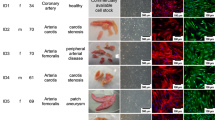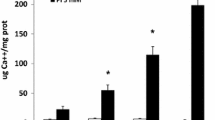Abstract
Vascular calcification (VC) is seen ubiquitously in aging blood vessels and prematurely in disease states like renal failure. It is thought to be driven by a number of systemic and local factors that lead to extra-osseous deposition of mineral in the vascular wall and valves as a common endpoint. The response of resident vascular smooth muscle cell to these dystrophic signals appears to be important in this process. Whilst in vivo models allow the observation of global changes in a pro-calcific environment, identifying the specific cells and mechanisms involved has been largely garnered from in vitro experiments, which provide added benefits in terms of reproducibility, cost, and convenience. Here we describe a 7–21 day cell culture model of calcification developed using immortalized murine vascular smooth muscle cells (MOVAS-1). This model provides a method by which vascular smooth muscle cell involvement and manipulation within a mineralizing domain can be studied.
Access this chapter
Tax calculation will be finalised at checkout
Purchases are for personal use only
Similar content being viewed by others

References
Blacher J, Guerin AP, Pannier B et al (2001) Arterial calcifications, arterial stiffness, and cardiovascular risk in end-stage renal disease. Hypertension 38:938–942
Schwarz U, Buzello M, Ritz E et al (2000) Morphology of coronary atherosclerotic lesions in patients with end-stage renal failure. Nephrol Dial Transplant 15:218–223
Schlieper G, Aretz A, Verberckmoes SC et al (2010) Ultrastructural analysis of vascular calcifications in uremia. J Am Soc Nephrol 21(4):689–696
Sage AP, Tintut Y, Demer LL (2010) Regulatory mechanisms in atherosclerotic calcification. Nat Rev Cardiol 7:528–536
Jia G, Stormont RM, Gangahar DM et al (2012) Role of matrix Gla protein in angiotensin II-induced exacerbation of vascular calcification. Am J Physiol Heart Circ Physiol 303:H523–H532
Wu M, Rementer C, Giachelli CM (2013) Vascular calcification: an update on mechanisms and challenges in treatment. Calcif Tissue Int 93:365–373
Johnson RC, Leopold JA, Loscalzo J (2006) Vascular calcification: pathobiological mechanisms and clinical implications. Circ Res 99:1044–1059
Chalmers JA, Martino TA, Tata N et al (2008) Vascular circadian rhythms in a mouse vascular smooth muscle cell line (MOVAS-1). Am J Physiol Regul Integr Comp Physiol 295:R1529–R1538
Afroze T, Yang LL, Wang C et al (2003) Calcineurin-independent regulation of plasma membrane Ca2+ ATPase-4 in the vascular smooth muscle cell cycle. Am J Physiol Cell Physiol 285:C88–C95
Rivera J, Walduck AK, Thomas RR et al (2013) Accumulation of serum lipids by vascular smooth muscle cells involves a macropinocytosis-like uptake pathway and is associated with the downregulation of the ATP-binding cassette transporter A1. Naunyn Schmiedebergs Arch Pharmacol 386:1081–1093
Smith ER (2015) Isolation, characterization of calciprotein particles in biological fluids. Methods Mol Biol (in press)
Acknowledgements
Development of these methods was supported by a Jacquot Research Establishment Award to SGH. The authors are grateful to A/Prof. Grant Drummond for supplying MOVAS-1.
Author information
Authors and Affiliations
Corresponding author
Editor information
Editors and Affiliations
Rights and permissions
Copyright information
© 2016 Springer Science+Business Media New York
About this protocol
Cite this protocol
Kelynack, K.J., Holt, S.G. (2016). An In Vitro Murine Model of Vascular Smooth Muscle Cell Mineralization. In: Hewitson, T., Smith, E., Holt, S. (eds) Kidney Research. Methods in Molecular Biology, vol 1397. Humana Press, New York, NY. https://doi.org/10.1007/978-1-4939-3353-2_14
Download citation
DOI: https://doi.org/10.1007/978-1-4939-3353-2_14
Published:
Publisher Name: Humana Press, New York, NY
Print ISBN: 978-1-4939-3351-8
Online ISBN: 978-1-4939-3353-2
eBook Packages: Springer Protocols



